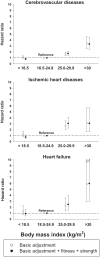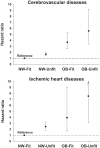Cardiorespiratory fitness, muscular strength, and obesity in adolescence and later chronic disability due to cardiovascular disease: a cohort study of 1 million men
- PMID: 31710669
- PMCID: PMC7154806
- DOI: 10.1093/eurheartj/ehz774
Cardiorespiratory fitness, muscular strength, and obesity in adolescence and later chronic disability due to cardiovascular disease: a cohort study of 1 million men
Abstract
Aims: Cardiorespiratory fitness, muscular strength, and obesity in adulthood are risk factors for cardiovascular disease (CVD). However, little is known regarding the associations of these risk factors, already in adolescence, with later disability due to chronic CVD. Hence, we investigated associations of cardiorespiratory fitness, muscular strength, and body mass index (BMI) in adolescence with later chronic disability due to specific causes of CVD disability (i.e. cerebrovascular disease, ischaemic heart disease and heart failure).
Methods and results: This population-based cohort study included 1 078 685 male adolescents (16-19 years) from the Swedish military conscription register from 1972 to 1994. Cardiorespiratory fitness (bicycle ergometer test), muscular strength (knee extension strength), and BMI were measured during the conscription examination. Information about disability pension due to CVD was retrieved from the Social Insurance Agency during a mean follow-up of 28.4 years. Cardiorespiratory fitness was strongly and inversely associated with later risk of chronic CVD disability for all investigated causes. The association was particularly strong for ischaemic heart diseases (hazard ratio 0.11, 95% confidence interval 0.05-0.29 for highest vs. lowest fitness-quintiles). Furthermore, overweight/obesity were associated with CVD disability for all investigated causes. Conversely, associations of muscular strength with CVD disability were generally weak.
Conclusions: This study provides evidence for associations between low levels of cardiorespiratory fitness and obesity with later risk of chronic disability due to CVD. Preventive actions may begin at young ages and include promotion of cardiorespiratory fitness and healthy body weight.
Keywords: Cardiorespiratory fitness; Cardiovascular disease; Disability; Muscular strength; Obesity.
© The Author(s) 2019. Published by Oxford University Press on behalf of the European Society of Cardiology.
Figures






Comment in
-
Adolescent health and future cardiovascular disability: it's never too early to think about prevention.Eur Heart J. 2020 Apr 14;41(15):1511-1513. doi: 10.1093/eurheartj/ehz869. Eur Heart J. 2020. PMID: 31819992 No abstract available.
References
-
- Joseph P, Leong D, McKee M, Anand SS, Schwalm JD, Teo K, Mente A, Yusuf S.. Reducing the global burden of cardiovascular disease, Part 1: the epidemiology and risk factors. Circ Res 2017;121:677–694. - PubMed
-
- Ross R, Blair SN, Arena R, Church TS, Després JP, Franklin BA, Haskell WL, Kaminsky LA, Levine BD, Lavie CJ, Myers J, Niebauer J, Sallis R, Sawada SS, Sui X, Wisløff U.. Importance of assessing cardiorespiratory fitness in clinical practice: a case for fitness as a clinical vital sign: a scientific statement from the American Heart Association. Circulation 2016;134:e653–e699. - PubMed
-
- Smith JJ, Eather N, Morgan PJ, Plotnikoff RC, Faigenbaum AD, Lubans DR.. The health benefits of muscular fitness for children and adolescents: a systematic review and meta-analysis. Sports Med 2014;44:1209–1223. - PubMed
-
- Ortega FB, Ruiz JR, Castillo MJ, Sjöström M.. Physical fitness in childhood and adolescence: a powerful marker of health. Int J Obes 2008;32:1–11. - PubMed
-
- Hogstrom G, Nordstrom A, Nordstrom P.. Aerobic fitness in late adolescence and the risk of early death: a prospective cohort study of 1.3 million Swedish men. Int J Epidemiol 2016;45:1159–1168. - PubMed

